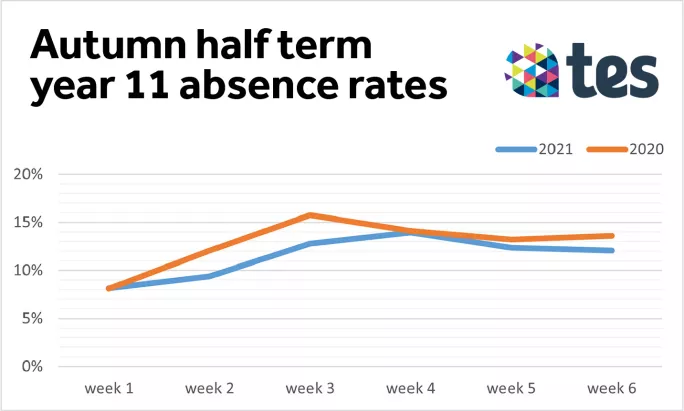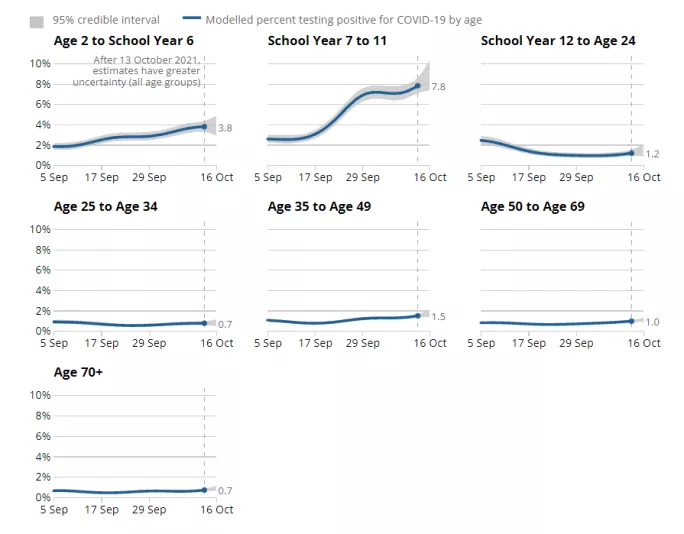
GCSEs 2022 ‘worry’ as Year 11s worst hit by Covid

Headteacher leaders are calling for an earlier release of exam materials as new data analysis reveals that Year 11s have experienced the highest absence rates of any year group this term.
In analysis of attendance data from 2,400 secondary schools from FFT Education Datalab, Year 11 students have missed 11.5 per cent of sessions during the first half of the autumn term, up to 15 October.
Covid: Where is pupil and teacher absence heading?
Warning: Heads raise staffing fears as Covid rates among teachers doubles
Inspection: Education secretary wants Ofsted to help improve attendance
While this is an improvement on the 13.6 per cent of sessions missed by Year 11 last year, this means the year group has missed more schooling than any other, with nearly double the absence rates of 2019 (6.3 per cent.
The data also shows that absence rates so far this term for students taking GCSEs next summer closely mirrors rates for Year 11s in the same period last year, whose exams were later cancelled in favour of teacher-assessed grades (TAGs).

Julie McCulloch, director of policy at the Association of School and College Leaders, told Tes that the disruption to their schooling caused by the ongoing pandemic this term will be a “worry” for schools, students and parents, particularly as many students will be preparing to sit mocks after half term.
Mock exams have even greater significance to 2022 exams as they may be relied upon to calculate grades if exams have to be cancelled once again next summer.
“The higher prevalence of Year 11 pupils missing lessons will be a worry for leaders, teachers, parents and the students themselves as we enter the second half of the autumn term, a period when many should be sitting their mock GCSE exams,” said Ms McCulloch.
“This is a very important period as they prepare for their exams during the summer term of 2022. This year’s GCSE cohort has already experienced the most tumultuous period in education since the Second World War.
“The government has set out some adaptations to next year’s exams in an attempt to take account of this disruption, including providing advance information on the content of some exams. Currently, the intention is for this information to be released at the beginning of February.
“Given the extent of the disruption many students are experiencing, we believe this date should now be brought forward to help students to focus their learning and revision and enable them to do as well as they possibly can in their GCSEs.
She added: “We hope the government’s last-minute stab at increasing uptake of coronavirus jabs among this age group by allowing them to book at vaccination centres during the half-term holiday doesn’t come too late in the day to prevent infection rates rising still further in the run-up to Christmas.”
Absence and Covid rates up for all secondary students
FFT Education Datalab’s analysis also shows that absence rates have risen in all year groups throughout the autumn term, mirroring Covid cases by age group data, which has once again shown that students in Years 7-11 have the highest positive rates than any other age group in England.
Data released by the Office for National Statistics today showed that the positivity rate increased in all age groups, except for those aged 25-34, where the trend was uncertain in the most recent week (ending 16 October 2021).
For secondary students, the positivity rate remained highest of all groups, with 7.8 per cent testing positive in the latest week.

Rates among secondary students have remained consistently high since the start of term. In the week ending 9 October, the infection rate hit 8.1 per cent, equating to 1 in 12 secondary students. In the week before - up to 2 October - one in 15 secondary students tested positive.
According to the FFT analysis, this has meant increased absence as the autumn term has progressed. For Year 7, there was a 4 per cent absence rate in the first week compared with an 8 per cent absence rate in the week leading up to 15 October.
In Year 8, the absence rate rose from 7 per cent to 10 per cent over the first half term, and in Year 9 from 8 to 11 per cent. Year 10‘s absence rate rose from 8 per cent to 12 per cent, as did Year 11‘s. In the week ending 1 October, Year 11 had an absence rate of 14 per cent, the same as in 2020.
“The good news is that absence is down on last year for every year group,” FFT analyst Katie Beynon said.
“Overall, secondary school pupils have missed 9.7 per cent of sessions so far this year compared with 11.3 per cent at the same point last year. There is, however, a rise in ‘other’ (ie, non-Covid-related) absences.
“The bad news is that this is still a long way above pre-pandemic levels. In autumn term 2019, pupils missed an average of 5.6 per cent of sessions, around 40 per cent fewer than the 9.7 per cent missed so far this year.”
Ms Beynon pointed out that schools are asked by the Department for Education to record students off with a positive Covid test as ill rather than unable to attend due to Covid, so that the rise in “other absences” is still likely due to a higher number of students testing positive for coronavirus.
A DfE spokesperson said: “We have put fairness at the heart of plans for next year’s exams, through a range of adaptations to recognise the impact of the pandemic on students’ education. Advance information on the focus of exam topics will be given in early February, to help students with their revision over the final months.
“Our priority is protecting face-to-face education, and vaccinations and regular testing are the best defence against the virus. That is why we are supporting schools to encourage their pupils to keep testing, as well as making it possible for 12- to 15-year-olds to get their jab at vaccination centres across the country.”
You need a Tes subscription to read this article
Subscribe now to read this article and get other subscriber-only content:
- Unlimited access to all Tes magazine content
- Exclusive subscriber-only stories
- Award-winning email newsletters
- Unlimited access to all Tes magazine content
- Exclusive subscriber-only stories
- Award-winning email newsletters
You need a subscription to read this article
Subscribe now to read this article and get other subscriber-only content, including:
- Unlimited access to all Tes magazine content
- Exclusive subscriber-only stories
- Award-winning email newsletters
- Unlimited access to all Tes magazine content
- Exclusive subscriber-only stories
- Award-winning email newsletters
topics in this article



